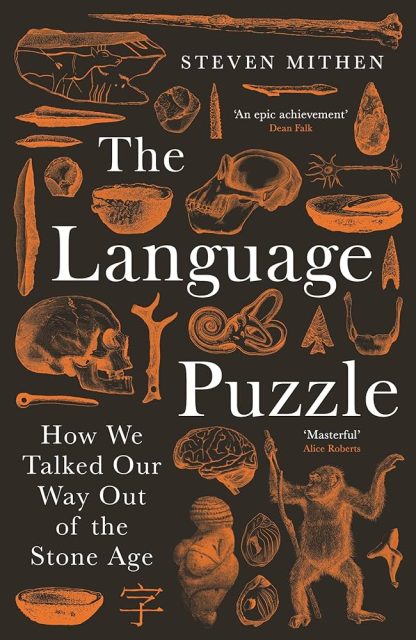The Language Puzzle: How it all began
Author: Juan F. Trillo, PhD in Linguistics and Philosophy (U. Autónoma de Madrid), PhD in Literary Studies (U. Complutense de Madrid).
It is clear that the world began before human beings learned to speak and even long before they made their appearance. However, as far as we are concerned and from our subjective point of view, “everything” began when we were able to articulate our thoughts as a sequence of meaningful words, for it was then that we began to become aware of our surroundings, ourselves and our place in the world.
Probably.
Because it is impossible to know it for sure, so in theory —the terrain in which operate those who study the origin of human language— any hypothesis, however far-fetched, could be correct. And this is a field of study in which everyone has one, often irreconcilable with the others, which has generated heated debates throughout history. So much so that, in 1866, just two years after its creation, the Paris Linguistic Society (predecessor of the International Linguistic Society, ILA) strictly forbade its congresses to discuss the origin of language until scientific advances provided information that would help to clarify the issue once and for all. Almost a century and a half later, and despite unsuspected scientific advances, the debate remains as intense as ever.
Steven Mithen, the renowned British archaeologist and professor at the University of Reading in Berkshire, England, has just published The Language Puzzle (Profile Books, March 2024), an extensive volume in which he attempts to piece together the picture of the origin of human language —the when, how and why of its emergence— by coherently uniting the numerous pieces that make it up. This must not have been an easy task, for to achieve it he has adopted a multidisciplinary approach in which he has taken contributions from sciences such as archaeology, anthropology, linguistics, genetics, neuroscience, psychology and ethology. But in his book, Mithen goes even further, examining how language and the cognitive process interact and influence each other respectively. He also reviews how the ability to speak allowed our ancestors to develop abstract concepts or metaphors, which in turn facilitated the development of agriculture and the creation of complex societies.

The author has arranged the chapters of his book according to the classic structure: first he tells us what he is going to tell us, then he tells us about it in detail, and finally he summarizes what he has told us, always with abundant references to previous or subsequent chapters, as appropriate. From the point of view of clarity of exposition, then, there is nothing to object to. On the contrary, everything has been arranged to prevent the reader from getting lost amidst an enormous profusion of data and information and to enable him to perceive the interaction of the factors that led to the emergence of human speech: the cries and calls that constituted a kind of proto-language, the anatomical changes that facilitated phonation, the ever-increasing social relationship of individuals, the transfer of knowledge, the selective pressure that favored groups with a more developed language, the ever-increasing size of the brain, the appearance of iconic words that allowed the elaboration of abstract thoughts….
This is a puzzle with many pieces and they are all there, distributed in 16 chapters and 134 subsections along 544 pages (hardback edition), in which Mithen deals with everything from the unconscious use of syntactic rules to iterated learning models, from the warning cries of apes to the introduction of sound symbolism in formal linguistics, from the formation and adoption of new words to a quick lesson on the human genome and how it influences certain language disorders. It is a monumental work, and it is not for nothing that the number of entries in the bibliography section is close to 800.
The Language Puzzle is well written and full of interesting ideas set out in an accessible way, which, given the amount of information involved, is an achievement in itself. However, when we finish reading it, we can’t help but feel a certain sense of disenchantment. At the beginning of his book, Mithen proposes a mystery —the origin of language— and throughout the book he shows us clues, hints, with which he elaborates his hypothesis. But when we reach the end, the mystery, far from being solved, remains as impenetrable as at the beginning. Mithen limits himself to telling us what might have happened; in other words, yet another more hypothesis, plausible, even probable, but a hypothesis nonetheless.
Perhaps the most notable contribution of his work is the proposal that, if his calculations are correct, humans learned to speak —in a rudimentary form, a kind of proto-language— 1.6 million years ago, much earlier than most of his colleagues consider likely, which is about 200,000 years ago. Of course, linguistic evolution was very slow, beginning to acquire the sophistication that human language enjoys today “only” about 150,000 years ago, with the appearance of the anatomical modifications that now allow us to speak fluently.
Mithen is inevitably forced to speculate on how events might have happened, though he does so with unimpeachable reasoning. Like other specialists, he constructs his personal puzzle from the many clues available, but it is important to remember that “evidence” and “clues” are not the same thing. While the former prove, the latter merely suggest, and unfortunately, we still do not have evidence that would reliably reveal how language arose. It is, after all, a mystery that we are not much closer to solving than when the Paris Linguistic Society banned debates on the subject, although at least now we are discussing it more calmly.
2 comments
[…] A review for Mapping Ignorance Magazine. […]
[…] Una reseña científico-literaria para Mapping Ignorance Magazine. […]